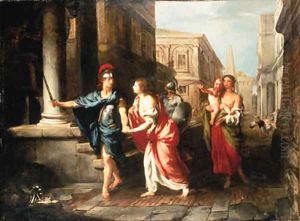Francesco Fernandi (Imperiali) Paintings
Francesco Fernandi, also known as Imperiali, was an Italian painter of the late Baroque period. He was born in 1679 in Rome, Italy. Fernandi received the nickname 'Imperiali' due to his patronage by Livio Odescalchi, who was the Duke of Bracciano and a nephew of Pope Innocent XI. Odescalchi held the title of Prince of the Holy Roman Empire ('Imperiale' in Italian), which influenced the nickname given to Fernandi.
Fernandi trained under the prominent painter Benedetto Luti and also worked with Filippo Lauri. His early works were influenced by the style of his mentors and reflected the Baroque sensibility of dynamic compositions and dramatic use of light and shadow. He specialized in history painting, creating works with religious and mythological themes that were characterized by their vibrant colors and energetic figures.
Throughout his career, Fernandi received commissions from various religious institutions as well as from noble families. His work can be found in several churches in Rome, including the Basilica di San Giovanni in Laterano and Santa Maria dell'Anima. He was also active in decorating palaces and villas, where his frescoes and altarpieces further solidified his reputation.
Unfortunately, despite his contributions to the Baroque art scene in Rome, Fernandi did not achieve the same level of fame as some of his contemporaries, such as Giovanni Battista Tiepolo or Sebastiano Conca. Nevertheless, his works are appreciated for their technical skill and the emotion they convey.
Francesco Fernandi died in 1740 in Rome. His art remains a testament to the rich cultural environment of 18th-century Rome and continues to be studied by art historians and appreciated by art enthusiasts for its embodiment of the Baroque spirit.
